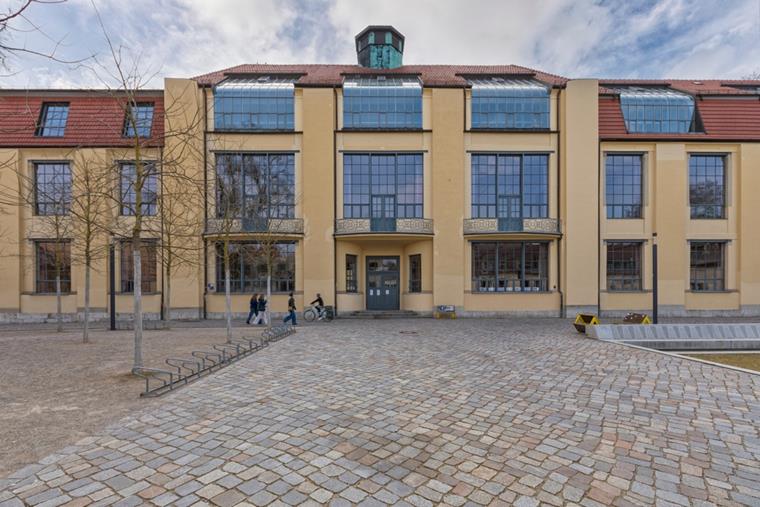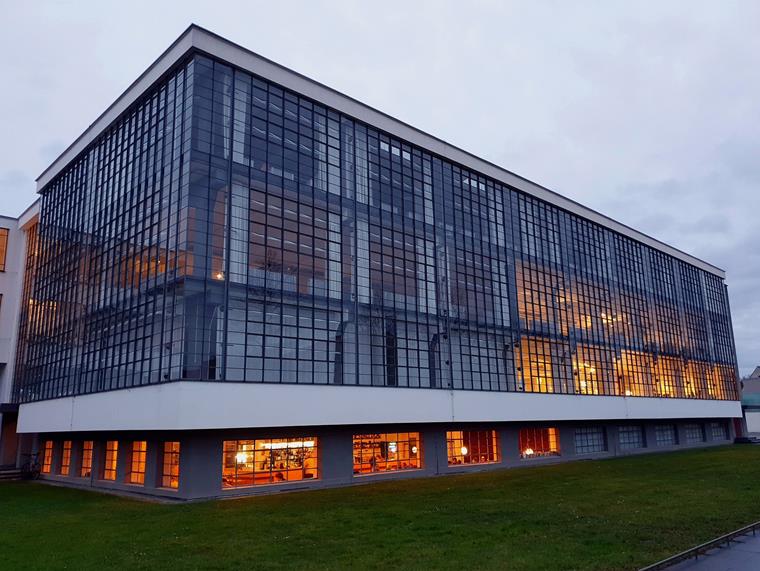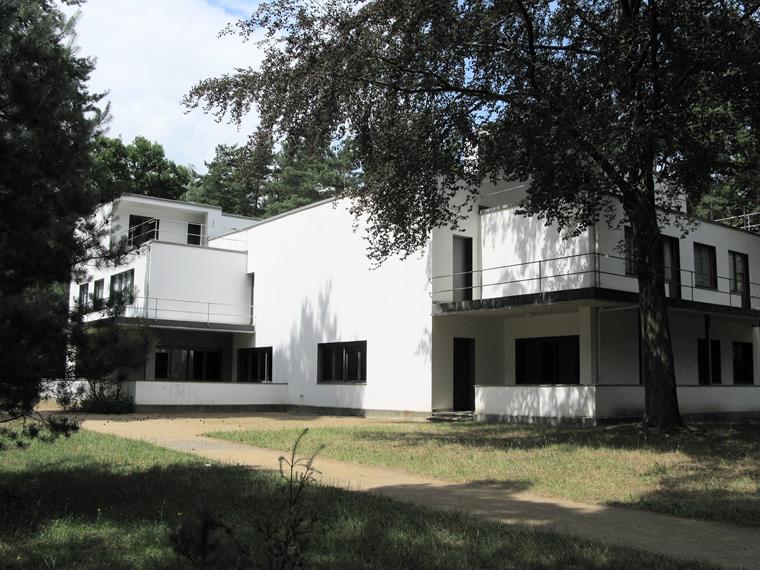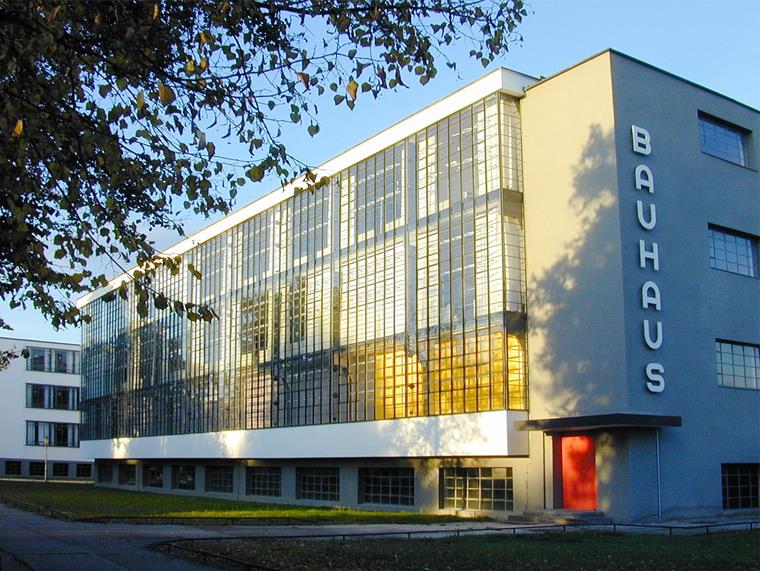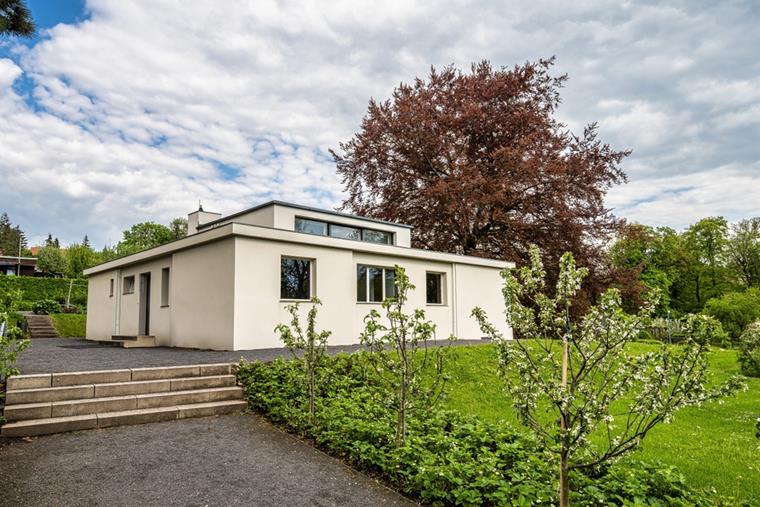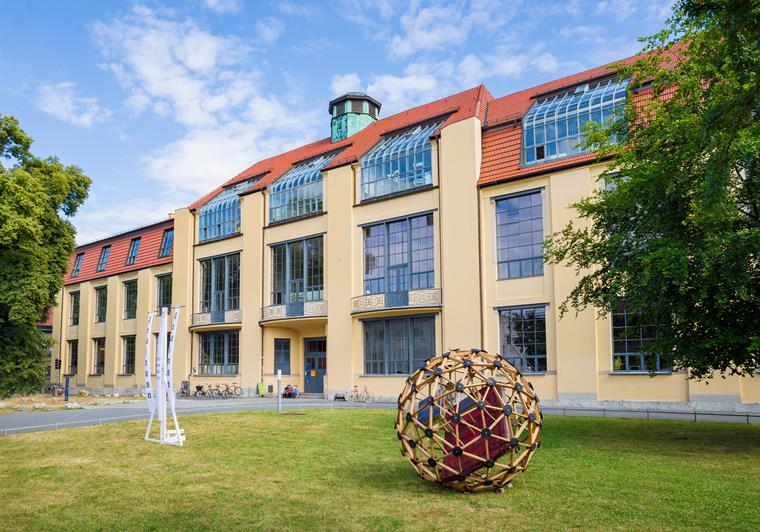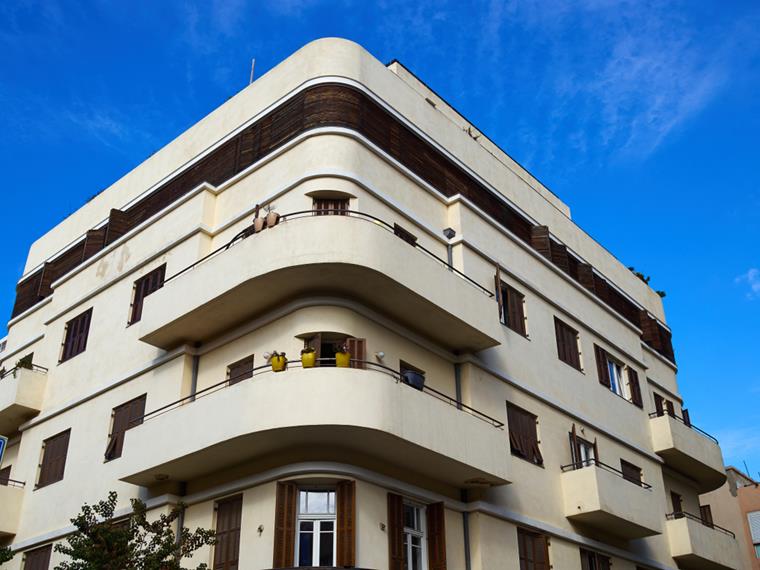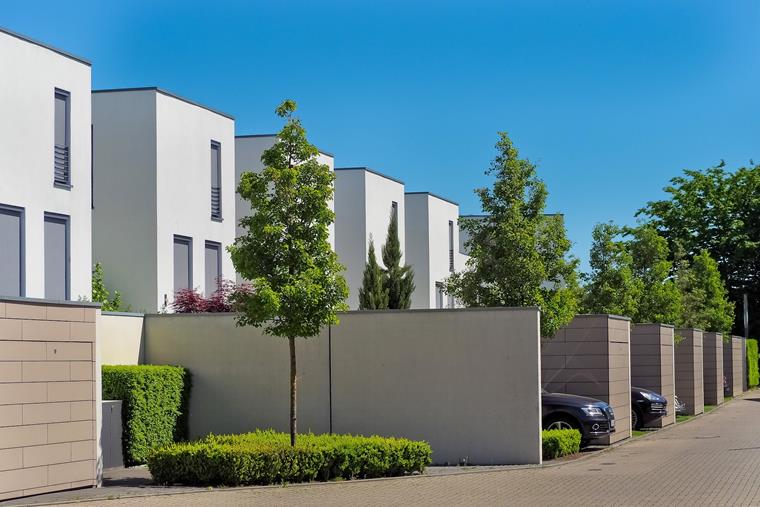Many different architectural styles were developed after World War I. There was a shortage of resources, and a lot had happened in society as well. People no longer wanted anything to do with the monarchy nor with ornate, elaborate facades. New ideas were needed.
In our previous blog post, we talked about the New Building movement. A new approach in architecture that attaches great importance to rationality and functionality. Based on this movement, other movements emerged; the most famous of them is the Bauhaus style. Starting in Germany, it was carried rather involuntarily all over the world and formed international roots, which still have a great influence on modern construction today.
In this blog post, we take a closer look at the history and interesting buildings of the Bauhaus style. In the end, we summarize: What makes the Bauhaus style so special, and what remains of it to this day? And can we learn a little more from Bauhaus architecture?
History of Bauhaus Style
To be more specific, the Bauhaus itself is not a pure architectural style. Initially, architecture was only a smaller part of it. Rather, the Bauhaus is one of the most influential art schools and design movements of the 20th century. This form of building is based on the former building huts of medieval cathedrals, which were used as workshops for parts of the huge buildings: hence the term Bauhaus.
Foundation and Identity
The Bauhaus was founded in Weimar in 1919, by an architect we already know from the New Building movement. Walter Gropius created a completely new approach to art, architecture, and design. It was certainly a very exciting time, especially for engineers.
A special thing is that when founding the Bauhaus, women were also offered free admission to a public art school for the first time, although not for all the professions taught there. In the beginning, even more women than men enrolled at the Bauhaus.
Gropius' idea: Arts and crafts should grow together and form a unit. Creativity and functional design are not mutually exclusive. A really interesting approach, isn't it? However, the Bauhaus found many supporters, but also quite a number of skeptics. After founding the Bauhaus, three phases of the Bauhaus history arose, which we would like to introduce to you.
The original Bauhaus was located in the Weimar site under the direction of Walter Gropius. In order to create something new from the ruins of World War I, Gropius worked on new concepts. Furthermore, it was important to him to create an affordable, but high-quality environment for all people despite the scarcity of raw materials. Of course, this also included architecture.
In an interdisciplinary environment, artists, craftsmen, and engineers would work together to develop a radically new design language. High-quality functional minimalism, without neglecting the artistic aspect: this approach led to the Bauhaus style.
Relocation and Prosperity
Due to changing political power relations in the German federal state of Thuringia, the Bauhaus had its funding cut in 1924 and a decision was quickly made: the Bauhaus had to move. The choice ultimately fell on Dessau. Here, Walter Gropius designed a new, modern building that embodied the ideals of the design school: the epitome of the Bauhaus architecture today.
An intensive creative period followed, which produced some of the most famous Bauhaus masterpieces. The collaboration with industry provided many designs that are still widely used today, especially in the field of furniture and interior design. For example, the first cantilever chairs were created at that time.
With his resignation as director in 1928, Gropius gave way to the Bauhaus architecture. His successor, the Swiss architect Hannes Meyer, focused not only on intensive collaboration with industry, but also – true to his craft – on more intensive engagement of the Bauhaus students with architecture.
In 1930, the management changed again and the famous architect Ludwig Mies van der Rohe became director of the Bauhaus in Dessau. After the NSDAP won the municipal election in Dessau in 1931, the closure of the Bauhaus was enforced a year later.
The Bauhaus Design was frowned upon by the Nazis, so van der Rohe had no choice but to try to preserve the Bauhaus as a private institution by moving to Berlin.
Architecture in Exile
In Berlin, the private Bauhaus building was also ill-fated. While the Bauhaus in Dessau was misused as a cooking and sewing school for countrywomen, and later as an administrative office, van der Rohe also soon had to give up his plan to keep the Bauhaus in Berlin alive. The leading NSDAP considered the purist’s minimalistic design to be too provocative.
It did not take long before the political situation in Germany led to many Bauhaus teachers and their students being forced to go into exile in order to further pursue their vision. This led to the international spread of the Bauhaus style. Today, the Bauhaus Design is still considered to be the Germany’s biggest export, because it met with international approval and had a lasting impact on many modern architectural styles.
Features of Bauhaus Architecture
As we already know, the Bauhaus design was intended to help unify art and technology. In Bauhaus architecture, form and function were to form a unit. How can we recognize the Bauhaus style in architecture? We have summarized the most important features of Bauhaus architecture:
- Often cubic, always simple geometric shapes
- Flat or duopitch roof without eaves
- Primary colors (red, blue, yellow), often with a white plaster facade
- Darkened windows
- Large glass surfaces
- Straight and clear lines
In engineering, Bauhaus projects stood out from the mass of contemporary buildings, due above all to the use of modern materials. Concrete was a particularly important material. At the beginning of the 20th century, it was commonly used for building foundations, bridge construction, and water pipelines. Creating entire buildings from it was something new.
Industrial steel was also an uncommon material for building houses at that time. Steel was mainly used for ornaments and pans, but later also for weapons. The situation was similar with glass as a material. With these innovative materials, the Bauhaus created completely new possibilities for the construction industry.
Examples of Bauhaus Architecture
The application areas of Bauhaus architecture covered a wide field. Whether the development of industrial plants or the creation of affordable residential space: every building should be a modern piece of art.
However, the Bauhaus became particularly known for its commitment to social housing. At that time, working with standardized components that were as large as possible was something new. Here we can find the pioneers of today's modular construction. Even today, houses with a cubic shape and flat roofs are very popular in residential construction. So let us take a closer look at some interesting buildings.
Bauhaus Architecture in Germany
Bauhaus Dessau
Dessau, Germany
Let us start with what is probably the most famous building of the Bauhaus style. The "Bauhaus" school of the same name originated as a Bauhaus workshop in Dessau. Like the masters’ houses, the residences of teachers at the Bauhaus, it was designed by Walter Gropius himself, and is considered a milestone in the history of architecture.
The large window facades in connection with industrial steel are also very impressive. Construction began in 1925 and was completed a year later. Art and technology should flow together here for a total work of art.
The structure itself is particularly interesting here. The innovative steel frame structure allowed for use of the characteristic glass surfaces, which cover large areas of the building. This arouses a feeling of openness and connection with the outside world. Today, the planning and construction of such a steel structure is common, but at that time, it was technically very demanding to implement it.
The flat roof was also something special. It not only had to be waterproof, but also provide enough stability to take the loads in case of heavy snowfall. This required detailed and precise structural design.
The Bauhaus workshop created mainly well-designed everyday objects. It was not about artistically valuable individual pieces. To this day, many pieces are still famous, such as Marcel Breuer's tubular steel furniture, Marianne Brandt's ashtrays, the steel house, and the absolute top seller: the Bauhaus tapestry.
The Bauhaus in Dessau has been on the list of UNESCO World Heritage Sites since 1996, and in 2001, it was included in the German Blue Book, a list of important cultural institutions in Eastern Germany. Today, the "Bauhaus Dessau Center for Design" is again a lively place of experimental design, research, and teaching.
Haus am Horn
Weimar, Germany
The Bauhaus exhibition requested by the state of Thuringia took place in Weimar in 1923, and showed a large number of the Bauhaus style works. The joint project of a model house built entirely in the Bauhaus style was particularly noteworthy. Georg Muche, a Bauhaus master, worked on this together with architect Adolf Meyer and painter László Moholy-Nagy.
As a representation of Bauhaus architecture, which was a rather small part of the overall concept at that time, the "Haus am Horn" shaped the idea of functionality and efficiency. The focus was on meeting modern living requirements, and this was seamlessly combined with innovative approaches to space utilization and furniture design.
The cubic shapes, clear lines, and flat roof are typical features of the Bauhaus style here. The model house was both an experimental building and an advertising space for new materials and technologies, and it brought together the work of all Bauhaus workshops into one community project.
Ultimately, the "Haus am Horn" was groundbreaking for modern house construction. This example significantly influenced subsequent architects and designers. It showed how modern technology and design principles could be combined. After reconstructions and dismantling, as well as numerous renters, the house came into the hands of the city. In 2019, the foundation handed over the "Haus am Horn" to the Classic Foundation Weimar.
Bauhaus University
Weimar, Germany
In the city of Weimar, the birthplace of the Bauhaus style, the renowned German university of arts and design still invites students to study in its halls. With a focus on architecture, engineering, and design, it also sets the standards at the international level.
The university originally dates back to the Grand Ducal Saxon School of Art, which was founded in Weimar in 1860 by Grand Duke Carl Alexander. In 1902, it was transformed into a state institution. The main building was built between 1904 and 1911 as a studio building for the university, designed by Henry van de Velde. To this day, it is one of the most important buildings of the turn of the century in terms of art schools.
The Weimar Art School and Sculpture School were merged, and later elevated to the Grand Ducal Saxon School of Fine Arts in 1910. The Weimar School of Arts also plays a role here. These various schools were finally unified in 1919 by Walter Gropius to found the State Bauhaus Weimar.
An art school was created as a pioneer of modern art. Due to differences in content, a State University of Fine Arts was set up in 1921. While the Bauhaus had to move to Dessau in 1925, the Weimar Bauhaus was renamed the School of Design and in the following decades went through numerous other stations of its identity due to great social upheaval.
In 1996, the university was included in the list of UNESCO World Heritage Sites as the founding place of the Bauhaus movement. In 1999, the university was restored to its original state as part of a renovation carried out by architect Thomas van den Valentyn. Today, typical Bauhaus elements can be found, especially in the interior.
Bauhaus Archive
Berlin, Germany
Admittedly, the Bauhaus Archive, or Museum of Design, was not established at a time when the Bauhaus still existed in Germany. Nevertheless, it was built entirely in the Bauhaus style, not least due to the fact that it was designed by Walter Gropius himself.
Here, you can find the most extensive collection on the Bauhaus history in the world. It opened in 1979, but it quickly became clear that it would soon be too small. The requirements of a museum with an archiving function have become greater over time, as well as the number of visitors and the collection itself.
In 2018, renovation and expansion work began. An extension is currently being planned under the direction of the architect Volker Staab. The exhibition area is to be increased from 700 m² (7,535 ft²) to 2,000 m² (21,528 ft²) by the time the museum reopens in 2025. The proximity to the Landwehr Canal and the inner-city location of the property were particularly challenging during the construction work. For example, the city's water pipelines require underground construction for civil engineering works.
While reinforced concrete is used for the basement of the new building, the glass tower is a light steel-timber structure. For this project, Staab Architekten developed a new kind of steel structure, consisting of 693 slightly inclined columns. In addition to the existing sawtooth roofs from Gropius' plans of the existing building, this special tower will be the new architectural landmark of the Bauhaus Archive.
Bauhaus Architecture International
When the National Socialists took power in 1933, the Bauhaus style period came to an end in Germany, but this architectural style was also very popular abroad. The famous Bauhaus masters and many of their students joined other modern art schools, where their ideas found fertile soil.
The Bauhaus style from Germany thus contributed significantly to the development of the "International Style". It is still used all over the world today and leads to truly impressive construction projects. Together, we will take a closer look at one of the most interesting, if not the most interesting, of these projects.
White City
Tel Aviv, Israel
The White City was built by European architects between 1937 and 1950. The majority of them were trained in Germany and fled to Palestine to escape the influence of National Socialism. Tel Aviv, in particular, became their haven.
To date, more than 4,000 buildings with typical features have been created in the Bauhaus style here. Balconies, clear horizontal lines, flat roofs, and white plaster facades consist of the usual modern materials: concrete, steel, and glass. Due to this construction method, elegance and uniformity run through the entire district. In fact, it is the largest concentration of buildings in the Bauhaus style in the world.
This district also enjoys high international recognition. Finally, in 2003, the White City in Tel Aviv was listed as a UNESCO World Heritage Site. Five years later, in 2008, a Bauhaus Museum opened here, which allows visitors to experience this very special architectural style.
Conclusion Bauhaus Style
The Bauhaus style has a very eventful history that continues to the present. Even today, we can still find approaches or typical features of the Bauhaus style in many modern buildings. The idea of a building becoming a total work of art, consisting of art and technology, is really fascinating. As both do not have to be mutually exclusive.
At the same time, the Bauhaus style is an example of how construction methods that are unusual at the time can gradually prevail; that is, develop into a new standard. So let us summarize what insights we can take from the Bauhaus style in our modern construction.
What can we learn from Bauhaus?
Since its origin, the Bauhaus style has been a great source of inspiration for engineers. Bauhaus architecture has had a lasting influence on engineering. In particular, the use of new building materials is also very interesting for our construction industry.
The use of steel and concrete in Bauhaus buildings provided higher structural integrity. Nowadays, reinforced concrete is the most common building material, so it has prevailed accordingly. At this point, however, it has to be said that this new standard is currently being increasingly criticized, and rightly so. Because reinforced concrete is a real climate killer and causes tons of additional CO2 emissions worldwide.
At this point, we should not take over the materials of the Bauhaus style, but the idea behind it. The use of alternative materials with, for example, significantly better properties can cause our construction industry to take a big step forward. Against all resistance and arguments, such as “we have always done it this way”, it is now time for a new change in our industry, as the Bauhaus was for the early 20th century.
By focusing on the essentials, namely creating functional, aesthetically appealing buildings that people also feel comfortable in, we can take different paths than before. In modern construction, there are already experimental technical approaches and new (or old) building materials that use fewer resources and reduce the environmental impact of construction. You can read a lot about many of them in this blog.
Interdisciplinary collaboration between artists, architects, scientists, and engineers will continue to be important in the future. This way, we can create new visions together and lay the foundation for a construction industry that goes hand in hand with a sustainable future.
